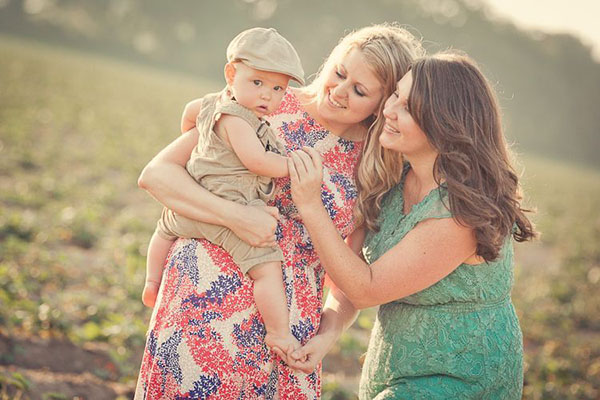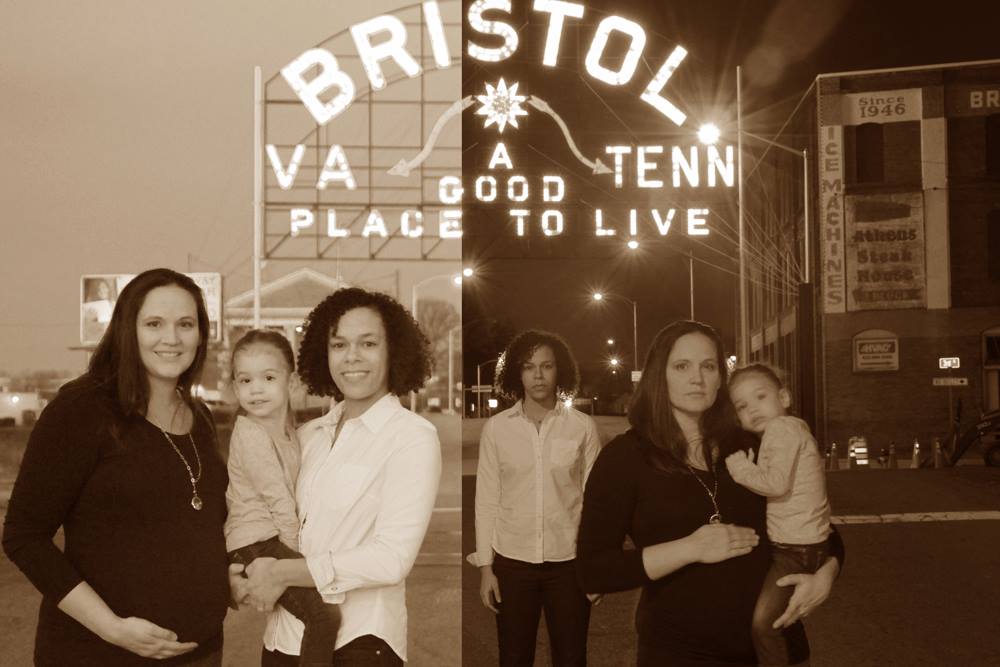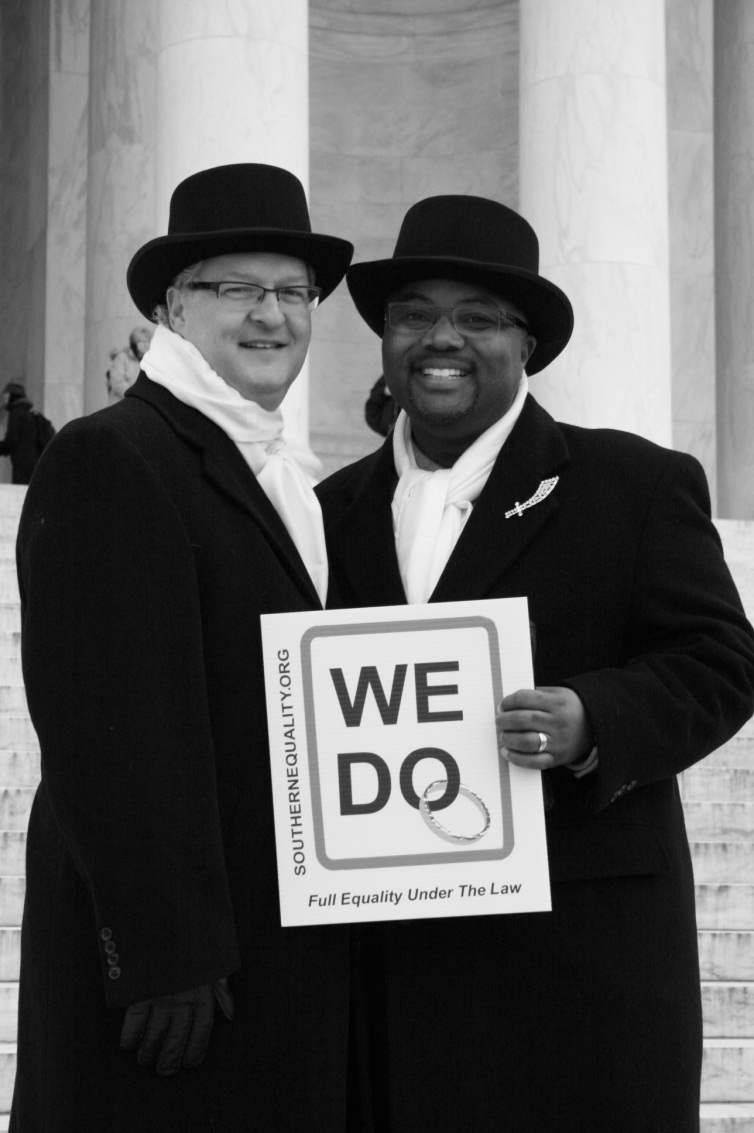Digital Storytelling:
Spotlighting Same-Sex Couples and Other Messengers Online
A vital component of Freedom to Marry’s campaign to win marriage for loving, committed same-sex couples nationwide was conveying again and again – in many different ways - why marriage matters and to whom it matters. Through stories of same-sex couples impacted by marriage discrimination and people who support the freedom to marry, we were able to make an urgent case for winning marriage for same-sex couples, demonstrate the diversity of support that existed for the freedom to marry, and shift public opinion.
Our central goal was always to spark and frame the millions of conversations we knew we need to change hearts and minds and build momentum and a critical mass of support.
Much of Freedom to Marry’s storytelling work was concentrated (or originated) online. Through more than 200 written online profiles, dozens of videos and advertisements, placements in traditional media outlets, and social media, Freedom to Marry was able to consistently and authentically showcase the faces of people from all across the country who needed to be able to say “I do,” marry in any state they chose, and be sure their marriages would be respected by the all states and the federal government. Our central goal was always to spark and frame the millions of conversations we knew we need to change hearts and minds and build momentum and a critical mass of support.
Development of Narrative Storytelling Work

Natalie Fox and Leah Nichols and their son Hayes from Mobile, Alabama were one of the first same-sex couples featured for our Southerners for the Freedom to Marry campaign, underlining the importance of marriage in all 50 states. Read it here.
Following an intensive recalibration of how best to emphasize our authentic messages and bring in the next swath of supporters of the freedom to marry, Freedom to Marry committed significant resources of talent and money to disseminating the stories of same-sex couples harmed by the denial of marriage: attention not just to message, but message delivery. As Freedom to Marry worked with state and national partners to build campaigns in a broader array of states, many of which had only recently begun engaging with the marriage conversation, the stories (real families, real journeys, real examples both of love and commitment and of discrimination) were vital for demonstrating why the freedom to marry was so important.
Freedom to Marry invested significantly in its digital team in order to be better able to pursue new, innovative ways to drive marriage campaigns on a national level as well as in the states. Freedom to Marry’s digital team worked to identify same-sex couples, then interviewed them and wrote in-depth, 10+ paragraph profiles about each. We posted the pieces to our social media channels, disseminated them widely, and got a great response. The stories covered a wide range of topics – and featured a broad array of families. We wrote about married binational same-sex couples, connected with other military families, and focused on Southern families. We also situated same-sex couples in their larger family context and wrote about the journey stories of what we thought of as their “non-gay validators.”
As we featured more and more families, same-sex couples began reaching out to us, sharing their stories without us even asking them to. They talked about their wedding, their marriage that was not respected in their state, the journeys to acceptance that their family members shared with them, their hopes to raise children in a country where all people are treated equally. We dedicated significant time to these profiles, generating smart, strategic, on-message content that engaged our audience and gave people even more opportunities to connect with our national campaign.
Quickly, these written profiles became vital parts of any state marriage campaign. Freedom to Marry’s Digital Action Center ensured that each campaign website launched with 4-5 stories of same-sex couples, as well as allies (family members, conservatives, veterans, business owners). During the 2012 ballot campaign, no campaign website had a section dedicated to stories; by May 2013, every single marriage campaign used written profiles to disseminate messaging and engage supporters.
A Broad Range of Messengers

Satyam Barakoti and Tonja Holder from Atlanta, Georgia shared their story with us and Georgia Equality in 2013. Read it here.
In April 2013, we launched Freedom to Marry’s Story Center, aggregating all of the personal stories into one curated collection (rather than simply publishing them as blog posts). The stories always featured 8-10 strong photos (which we would then use on social media and in other various Freedom to Marry programs). The stories allowed us to build strong relationships with these families, gave our supporters something to organize around, and became a content engine for us to create the drumbeat about why marriage matters. The stories ranged from narratives about the real, tangible harms of marriage discrimination to celebrations about the joy that the freedom to marry brings once it is finally the law of the land in a state.
Throughout all of these phases of the effort to showcase real couples and families, we logged the contact information and descriptions of each family into a large master database that helped us get a grasp for all of the people we are connected to – and made it easier to connect with these families when we wanted to help a reporter reach a family impacted by the freedom to marry or marriage discrimination.
When necessary, we set up and pushed out through our email network and social media platforms sign-up forms that acted as story collection devices. We sent these forms (“Share Your Story,” generally) targeting same-sex couples from across the country who had married or wanted the freedom to marry in their state. Other times, we specifically needed stories out of certain states, so we would geo-target the social media links on Facebook or geo-target the email ask to people in that state.
Why Collect Stories of Same-Sex Couples?
Beyond the obvious – that stories provided consistent, engaging content for online campaigns – the process of collecting and executing these stories served many purposes and impacts many different facets of a campaign. We collected stories and devoted effort to this process for several reasons:

Stephen and Eddie Inman-Crawley were one of the first same-sex couples to marry in Arkansas in May 2014 following a judge's order. The couple shared their story with us, explaining that even with a valid Arkansas marriage license, their family was not secure. Read their story.
- To spotlight the stories of real families impacted by marriage discrimination and helped by the freedom to marry.
- To showcase the broad range of people who support the freedom to marry for same-sex couples.
- To demonstrate the wide diversity of same-sex couples impacted by the freedom to marry and convey that the freedom to marry cuts across all same-sex couples, regardless of race, age, hometown, economic status, body type, or family status.
- To package key talking points and messages in a more entertaining, readable framework and model important messages for supporters.
- To model for our supporters – especially soft supporters – the variety of people who are taking action in support of the freedom to marry and illustrating that these campaigns benefit the entire community.
- To build trust and relationships with community members we profile and open the door to higher levels of campaign engagement.
- To identify potential contacts for traditional communications work – op-ed authors, pitched stories, or connecting reporters with strong voices – fundraising asks, stories for field organizers, etc.
- To help potential media contacts better understand ways to talk about the freedom to marry and key language/messages.
- To identify additional subjects for online stories and social media content – parents, friends, high-level community partners.
- To give our supporters a way to connect with the campaign on a personal level and get invested in the work.
- To produce content that we could share on social media, pitch to bloggers, and generally use to put a face on this issue.
Key Lessons Learned
Put a face to your movement and show people and impacts at the heart of your cause: So often, social movements can feel like faceless issues – a bill, a court case, a ballot campaign. But to connect with Americans in a real way, it’s vital that people see the real faces and real lives of people affected. Freedom to Marry understood from messaging research and even just personal anecdotes that one of the key ways to change someone’s mind on the freedom to marry is through conversation with a same-sex couple and being encouraged to get to know real people and authentic stories Through our online storytelling work, we were able to help channel those stories into people’s newsfeeds, email inboxes, and computer screens, so that even if they didn’t have any personal connections who were gay or lesbian, they could see authentic, real families in front of them in a format that felt like a news story or video. Our stories were designed to spark conversations and generate shares among our supporters and, by extension, their groups of friends and family members who may not enthusiastically support marriage for same-sex couples.
Model opinions and values for others to become supporters of your issue with “ally” profiles or videos: In addition to featuring same-sex couples and people impacted by the denial of marriage, we also featured stories of friends, family members, and community leaders who supported the freedom to marry. The profiles were very similar to the profiles of same-sex couples: We spoke with the supporter, learned about their life, and through text and photo explored why they cared enough about this issue to speak out. These stories were especially impactful when we could spotlight a “journey” story – someone who previously did not support the freedom to marry but later changed their mind. Showing this narrative gave us a way to show that a non-supporter’s mind can be changed in the face of love and commitment, values that anyone can see are important and worthy of fighting for.
Use stories to package talking points and reiterate key campaign values: Freedom to Marry’s written stories and videos served as a great portal for the Freedom to Marry team to reiterate values that we knew resonated with “middle” voters. That is, messages like the “Golden Rule” – treating others like you’d like to be treated – or the idea that same-sex couples want to marry because they want to make a lifetime commitment to each other and be able to care for and protect each other. The entire messaging framework from “Why Marriage Matters,” Freedom to Marry’s public education network of resonant messages and themes for marriage campaigns, is evident in these profiles and throughout the campaign’s storytelling.

Photos like this one from Danielle and Jennifer Hounsell in Tennessee encapsulated so powerfully the impact of a state border. "If we cross into Virginia, we are a married couple and legally recognized as a family," they said. "But where we are right now, we're considered strangers." (Photo by Sean Trent)
Showcase the diversity of your cause with visual storytelling: The stories that Freedom to Marry featured captured the full range of people impacted by marriage discrimination – including strong geographic, racial, economic, gender, and religious diversity. Families of all sizes, shapes, and racial backgrounds, were featured. The photos and stories that we pushed out consistently demonstrated that all people should care about the freedom to marry because it affects every community.
Remember that online stories can – and should – be pursued to further other objectives: Freedom to Marry’s work on finding messengers and sharing their stories was not limited to our website or our social media channels. The storytelling process online functioned as a vetting process for us to understand which stories or images resonated most strongly with our audience. With that information in mind, the Digital team was able to work with the Communications team to pitch authentic and resonant stories of particularly strong messengers more broadly. The families that we spoke with became de facto “spokespeople” for Freedom to Marry and the national campaign to win marriage for same-sex couples. National and regional media contacted our Communications team looking to connect with real families who could speak about the marriage fights and provide a personal angle, and we were nearly always able to provide couples with attributes they were interested in profiling.
Promote your storytelling work – and others will share their own: By setting an example with strong stories featuring messengers on your social media platforms or websites, other supporters will proactively reach out to you without even being asked. On any profile or story, the page should prominently end with a “Share Your Story” button inviting readers to consider sharing their own story.

Through our partnership with the Campaign for Southern Equality, Freedom to Marry connected with dozens of same-sex couples, including Mark and Tim from North Carolina.
Connect with partners and reach out to others doing similar work for strong stories: There’s a good chance that many other groups, which may not have the capacity to do strong storytelling work, are well connected with wonderful messengers who perfectly illustrate why your issue is so important. To identify an expanded roster of stories, for example, Freedom to Marry enlisted and partnered with several partner organizations – namely, the Campaign for Southern Equality and the American Military Partner Association. We connected with both groups first from simple messages about the work they themselves were doing and later developed a mutually beneficial relationship that allowed us to push out the strongest stories possible on marriage. Similarly, we also connected with several creative art projects in hopes of finding strong stories to spotlight. The “Love is Love” photography project, for example, had beautifully photographed dozens of couples in Alaska, and so we asked them to put us in touch with the families so we could write about why marriage matters to them – and then promote these photos and stories online. Similarly symbiotic relationships developed with “First Comes Love" and the “Gay Warriors Project." There were also countless Facebook groups and other online communities featuring people who have plenty to say about why marriage matters, but they were often unaffiliated with a specific campaign or organization. Reaching out to these groups yielded some great responses.
Maintain strong relationships with messengers: Freedom to Marry profiles weren’t the sorts of things that we could quickly write and then retire forever. It was important to stay closely in touch with all of our couples and families, keeping them updated on what was going on with the national campaign and remaining friendly and non-transactional. We needed to call on these messengers – especially our strongest messengers – perhaps a half dozen to a dozen times, for conversations about their family members, and following these profiles we often had built up a very friendly relationship.
Don’t be afraid to experiment with format: Freedom to Marry’s Digital team worked to package stories of same-sex couples and their family members in many different ways, trying to experiment with different formats and forms of media and provide many different entry points for supporters and people in the moveable middle. These included written profiles with photos, videos, “round-up” posts featuring many different families and quick, one-paragraph blurbs about each family, first-person narratives that we would write like editorials and promote online, Facebook photos and short blurbs, and advocacy email blasts.
Be creative: Part of the goal with these stories was to package our message in a way that didn’t feel like we were packaging a message. That is, we didn’t want the stories to read like an organization was reciting talking points. The additional time and energy that went into each post was critical: By getting to know these same-sex couples and their supporters, we were able to get at the heart of what mattered to them and tell their story in a creative way that engaged readers and made the couple understand that we were really listening to them and really cared about what they had to say. The impact was clear: The posts that we wrote about same-sex couples and their families generated more than 750,000 visits to the Freedom to Marry website, helping us widely disseminate our messaging about why marriage matters in creative, innovative ways.